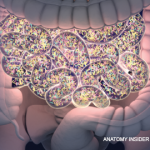In the 1970s two reports suggested that colonic Klebsiella pneumoniae is associated with ankylosing spondylitis (AS).23,24 More recently, microbiome studies of individuals with established AS have shown decreased sulfate-reducing bacteria in the colon.25 In the small intestine, there is an increased abundance of several taxa that are also augmented in Crohn’s disease, in concordance with the overlap of clinical manifestations between AS and Crohn’s disease.26
To date, the microbiome of AS has focused on established disease of approximately 10 years, but a small study of children with enthesitis-related arthritis demonstrated dysbiosis in all subjects with two distinct microbial patterns: One predominantly male cluster had a relatively high abundance of Bacteroides genus, and the second predominantly female cluster had a relatively high abundance of Akkermansia muciniphila.27 Whether these patterns reflect sex differences, prognosis or future clinical manifestations has yet to be determined.
Future Directions
Although many gaps exist in our knowledge of how the microbiome interacts with mucosal surfaces and, ultimately, shapes the immune system, this field is rapidly emerging within rheumatology. Studies of the bacterial, viral, and fungal microbiomes are underway in many diseases, and already have limited, but promising, results in systemic lupus erythematosus, Sjögren’s syndrome and Behçet’s.28-30
Our understanding of the microbiome as a causal mediator between health and disease is limited. Fecal transplant, the process in which intestinal flora from healthy individuals is transferred to those with disease, has been well established as an effective treatment of Clostridium difficile.31 A randomized placebo-controlled trial of fecal transplant in IBD showed mixed efficacy, with no change in quality of life or disease activity.32
Intriguingly, transplants from certain donors, termed superdonors, seemed to give significantly better outcomes. The study suggests that there are nuances to even healthy microbiome populations, and a much better understanding of the microbiome’s effect on the host is required before proceeding with therapies aimed at correcting dysbiosis.
Larger scale and longitudinal data also are currently lacking. The American Gut Project is collecting mail-in microbiome samples from various mucosal sites from anyone who applies online, including pets; they have amassed more than 3,000 samples.33 The NIH Human Microbiome project has initiated three longitudinal studies that focus on pregnancy, IBD and the onset of type 2 diabetes with multiple samples collected from the same individuals over more than three years.34 Currently, data are from patients with established disease; it remains unclear if dysbiosis drives autoimmunity or merely reflects the presence of existing inflammation. For rheumatologic diseases, we propose identifying high-risk individuals, as has been done with RA, and follow them long term, collecting multiple samples—for microbiome and immunologic assays—over time, even after disease is established and therapy initiated. In this manner, we can begin to understand the relationship between the microbiome, immune function and rheumatologic disease.
Summary
In 1683, Leeuwenhoek wrote a letter to the Royal Society of the Arts describing what he had seen when he looked at his own dental plaque under a microscope. He described “animalcules … were in such enormous numbers [and] seemed to be alive.”35 The first bacteria observed and described was our own microbiome. Even on initial observation, it was a dynamic and vibrant community. Emerging research suggests that shifts in our microbial flora may contribute or increase susceptibility to rheumatic diseases. Longitudinal and causal data are currently lacking but, with additional study, are promising and may point to novel methods of diagnoses or therapies.


